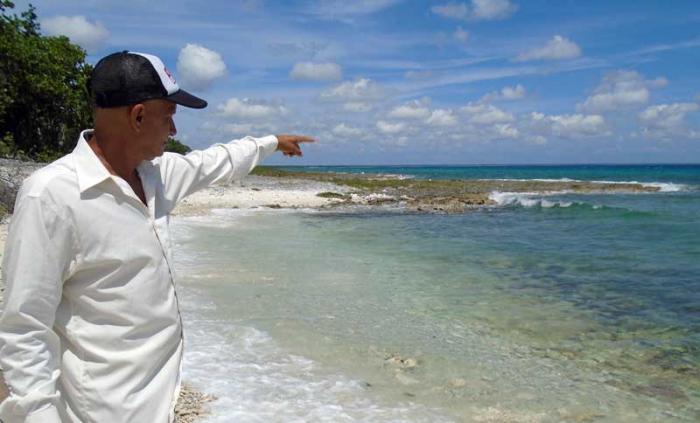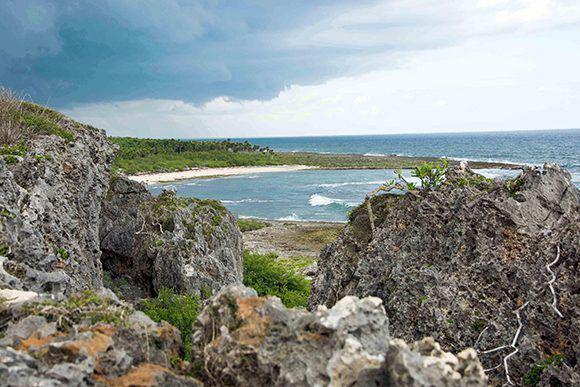
Pinar del Río.–They say that the first time Fidel arrived in the peninsula of Guanahacabibes, he was fascinated by its beauty.
“‘This is very valuable, take care of it,’ he said and I knew he was thinking about the future.
Many years have passed since that visit, but Comandante of the Rebel Army Julio Camacho Aguilera, the man who accompanied Fidel on that trip to the westernmost part of the country, remembers everything vividly.
The peninsula was a stretch of virgin land back then, as beautiful as it was remote, with a past marked by piracy, isolation and neglect.
The lush, practically untouched nature of the region had all the attributes to become a major tourist destination.
Comandante Camacho also understood this the moment he set foot here. Thus, after being linked to the region for some time, he became the main promoter of the creation of the Office for the Integral Development of Guanahacabibes (ODIG), approved by agreement of the Council of Ministers, 20 years ago.
The organization that will bring together, under its umbrella, the efforts of all organizations present in the territory declared a UNESCO Protected Area and Biosphere Reserve.
Now the peninsula has a highway, telephone communications, radio and television stations, tourist facilities, forestry and fishing activity, and rigorous scientific work to protect the environment.

In short, these are some of the achievements of an office that has worked hard to bring together the will of those who dream to make the peninsula’s progress come true.
All of this has been achieved despite those only interested in exploiting the area’s natural resources, and those who were of the opinion that the peninsula de Guanahacabibes should stay as it was.
Convinced that preservation of the ecosystems should be the premise of any action undertaken in the territory, Comandante Camacho has upheld the idea that its 22 beaches, its birds and reptile observation paths, its seabed with the most diverse coral reef in the Caribbean, its legends and stories should not remain unknown in the name of preservation.
“What’s the worth of having something so beautiful, if no one can see it?” he asks as he stresses that preservation is everyone’s task.
An ecosystem increasingly better preserved
President of the Ministry of Science, Technology and the Environment (CITMA) Environmental Agency, Maritza García PhD, explains that there has been consistent scientific work done over these two decades with the ODIG’s support.
“The marine turtle preservation project, for example, has attained international recognition. New species have been reported and the only farm for coral reproduction currently operating on the island was created here.”
“If the effects of climate change have not been as harsh here as in other regions of Cuba, it is thanks to the work of the Office,” García states.
Director of the Guanahacabibes National Park Lázaro Márquez Msc. says: “ODIG has not only promoted the building of infrastructure facilities, it has insisted that these are organically integrated within the environment.”
“From the moment of its creation, the efforts of scientific and academic organizations coming here to undertake all kinds of projects related to biodiversity have been articulated. One of these determined the existence of over a thousand of marine mollusk species,” Márquez explains.
“So 20 years later, we can say that the Office has favored development and, at the same time, preserved nature.”
ODIG director Comandante Camacho, recalls that in order to reforest the “bare spots” left by charcoal production, aerial photos were taken of the entire peninsula and later made available to the forestry enterprise.
“We have taken care of the sea and the land. We have fought poaching, reservoirs, under-water fishing, dredging. We are always concerned about the protection of nature because, without it, there is nothing else.”
When Camacho looks back, to the times when there was no highway, no radio or television, and to make a phone call, you had to drive dozens of kilometers, he feels that the change has been huge.
However, he says that the two upcoming decades will be even more important for the region.
“It has always been said that Cuba is the key to the Gulf, but the key is here in Guanahacabibes.”
“Along our coastline is the Yucatan Strait, the required path when navigating between the continent’s Northern and the Southern Hemispheres.”
“The Mayan Riviera, which receives millions of tourists a year, is only 40 minutes away by helicopter from the landing strip we have built here.”
“For that reason, I think the development of the zone we have foreseen so far and that includes the La Fe port, San Julián airport, and golf courses in Punta Colorada, open some beautiful perspectives.”
“I think we are not exaggerating if we compare it with the peninsulas of Hicacos. Only that it has Varadero, which is a worldwide renowned emporium of beauty and this is just beginning.”
IN CONTEXT
-The peninsula of Guanacahabibes has unique features of great importance for the environment, the economy and society, and as a site for submarine cultural heritage.
-In 1987, it was designated a Biosphere Reserve by UNESCO, and in 2001, became a National Park that contains two Natural Reserves: Cabo Corrientes and El Veral, which received the title in 1963.
-Guanacahabibes National Park, with its unique features, is a major Biosphere Reserve within the ecosystem surrounding it, holding interesting coral reefs. The park also boast countless species endemic to Cuba.
-The region characterized by a high level of endemic species and landscape values, is inhabited by 172 bird species from 42 families, 11 of which are endemic and 84 migratory. Experts consider that four of the seven species of marine turtles in the world survive in Guanacahabibes. The coral reefs off its shores are also very valuable.
-There are charismatic plants and many flowering species that provide nectar for bees, and others common in semidecidous forests such as jocuma, guasima, jagüey, ácana, majagua, guao de costa, nogal, jobo and ocuje, among others.
-The península of Guanacahabibes was one of the last refuges of indigenous peoples escaping Spanish colonizers. Preserved here are some 140 archaeological sites related to the life of these indigenous people, who were known in the región as Guanahatabeyes.
Source: Ecured















